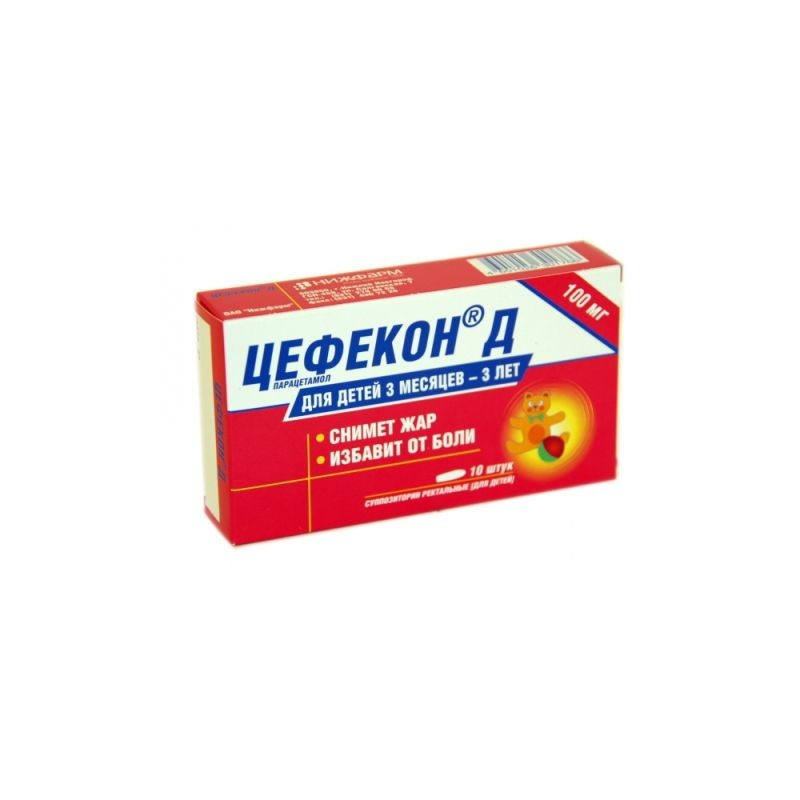



 All payments are encrypted via SSL
All payments are encrypted via SSL
 Full Refund if you haven't received your order
Full Refund if you haven't received your order
International brand name
Paracetamol
Packaging
Cefecon® D. Rectal suppositories for children 50 mg, 100 mg or 250 mg. 5 suppositories in blisters; two blister strip packagings, along with instructions for medical use of the drug, are placed in a carton box
Description
The suppositories are white or white with a creamy or yellowish shade of color, torpedo-shaped.
Pharmacodynamics:
Paracetamol has analgesic and antipyretic effects. The drug blocks cyclooxygenase in the central nervous system, affecting the centers of pain and thermoregulation. In inflammatory tissues, cellular peroxidases neutralize the effect of paracetamol on cyclooxiginase, which explains the absence of a significant anti-inflammatory effect.
The lack of a blocking effect on the synthesis of prostaglandins in peripheral tissues causes him no negative effect on water-salt metabolism (sodium and water retention) and the mucous membrane of the gastrointestinal tract.
Pharmacokinetics:
Absorption is high, rapidly absorbed from the gastrointestinal tract.The period of reaching the maximum concentration - 30-60 minutes. It penetrates the blood-brain barrier. The magnitude of bioavailability in children and newborns is similar to that in adults. Metabolized in the liver. The half-life is 2-3 hours. Within 24 hours, 85-95% of paracetamol is excreted by the kidneys in the form of glucuronides and sulphates, unchanged in the form of -3%. There is no significant age difference in the rate of elimination of paracetamol and in the total amount of the drug that is excreted in the urine.
Used in children from 3 months to 12 years as: - antipyretic for acute respiratory diseases, flu, childhood infections, vaccine-induced reactions and other conditions accompanied by fever; - painkillers for pain syndrome of weak and moderate intensity, including: headache and toothache, muscle pain, neuralgia, pain due to injuries and burns. In children from 1 to 3 months a single dose of the drug is possible to reduce the temperature after vaccination, the use of the drug for all indications is possible only by doctor's prescription.
Hypersensitivity to the components of the drug, age - up to 1 month of life. With care Disorders of the liver and kidneys, Gilbert, Dubin-Johnson and Rotor syndrome, diseases of the blood system (anemia, thrombocytopenia, leukopenia), genetic absence of glucose-6-phosphate dehydrogenase.
Dosage and administration
Rectally.After spontaneous bowel movements or cleansing enemas, the suppository is released from the contour cell packaging and injected into the rectum. The dosage of the drug is calculated depending on the age and body weight, in accordance with the table. A single dose is 10-15 mg / kg of body weight of the child, 2-3 times a day, after 4-6 hours. The maximum daily dose of paracetamol should not exceed 60 mg / kg body weight of the child.
1-3 months | 4 - 6 kg | 1 suppository of 0.05 g (50 mg) |
3-12 months | 7 - 10 kg | 1 suppository of 0.1 g (100 mg) |
1-3 years | 11 -16 kg | 1 - 2 suppository of 0.1 g (100 mg) |
3-10 years | 17 - 30 kg | 1 suppository of 0.25 g (250 mg) |
10-12 years | 31 - 35 kg | 2 suppository of 0.25 g (250 mg) |
Duration of treatment: 3 days as an antipyretic and up to 5 days as an anesthetic. Extension of the course if necessary after consultation with the doctor
Allergic reactions (including skin rash).
Interaction with other drugs
Liver microsomal oxidation stimulants (phenytoin, ethanol, barbiturates, flumecinol, rifampicin, phenylbutazone, tricyclic antidepressants), ethanol, and hepatotoxic drugs increase the production of hydroxylated active metabolites, which makes it possible for the development of severe intoxication, even with the toxico-toxic substances, to increase the production of hydroxylated active metabolites, which can lead to the development of heavy intoxication. Inhibitors of microsomal oxidation (including cimetidine) reduce the risk of hepatotoxic action.When taken with salicylates, the nephrotoxic effect of paracetamol increases. The combination with chloramphenicol leads to an increase in the toxic properties of the latter. Enhances the effect of indirect anticoagulants, reduces the effectiveness of uricosuric drugs.
With continuing febrile syndrome with the use of paracetamol for more than 3 days, and pain syndrome for more than 5 days, consultation with a doctor is required.
